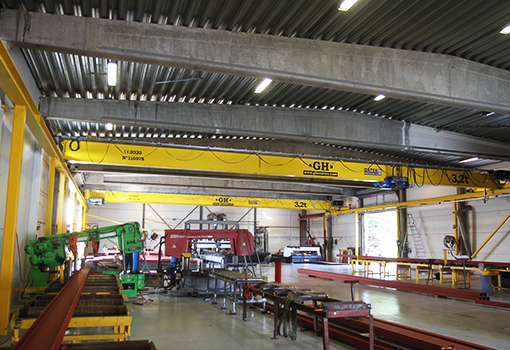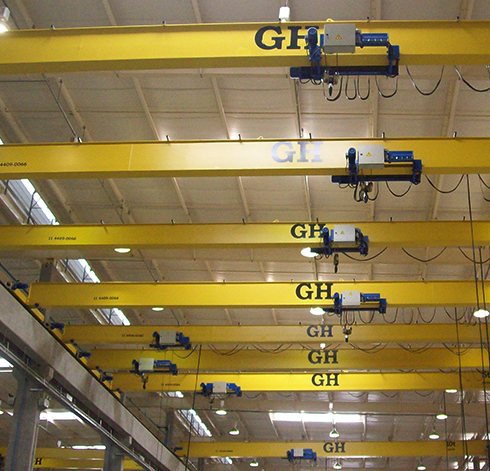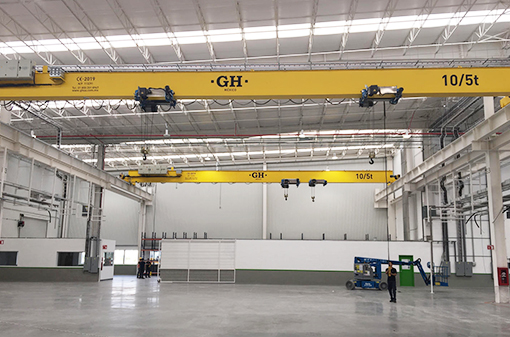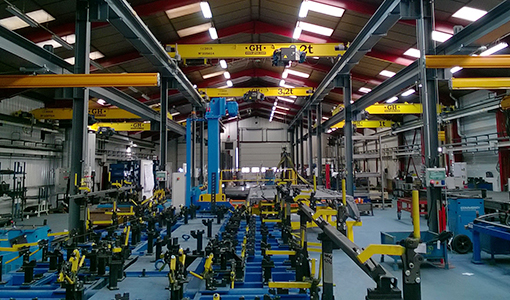Do you need to purchase a single-girder overhead crane? You must consider a number of vital factors to make sure you buy a crane system that meets your needs—today and tomorrow. When buying a single-girder overhead crane, you must consider safety, reliability, efficiency and more. Here are the top things to consider so that you buy the crane that is right for your application.
Single-Girder Overhead Cranes

First, let’s talk definitions. A single-girder overhead crane is a type of bridge crane that consists of two or more overhead runways built into the building’s support structure, with the girder (the bridge) running between the runways for the width of the crane bay.
At each end of the girder are end trucks that move the girder and the hoist forward and backward along the length of the runways. The trolly and hoist most commonly run along the underside of the girder.
Single girder overhead cranes have a number of advantages:
- Less expensive because of less material used in manufacture and simple trolley design
- Most economical option for light and medium duty applications
- Lower loads on your building structure and foundation
- Easy to install, service and maintain
1. Weight Capacity
The first thing you must think about is the amount of weight you will be lifting and moving. Regardless of whether you are lifting steel coils, equipment, concrete blocks, aerospace components or something else, you need a single-girder overhead crane that will handle the weight of your loads.
The thing to remember about single-girder overhead cranes is that they are designed for light to medium duty. They have limits when it comes to lifting capacity. The majority of single-girder overhead cranes are rated to lift and move loads of between 10 and 15 tons. So, if your loads are heavier than that, you need to be looking at a double-girder overhead crane instead.
Need to buy a single-girder overhead crane?
2. Span
You are likely looking to buy a single-girder overhead crane because it is one of the most cost-effective solutions. It uses less material and is lighter and more compact than a double-girder overhead crane. This makes is less expensive to build, ship and install.
Just remember that single-girder overhead cranes have a limit to their span. Most models on the market are limited to spans of up to 60′, since most rolled sections are available in lengths of up to 60′. If your span is greater than 60′, you need a stronger crane, such as a double girder or monobox design.
3. Classification
All overhead cranes are classified according to loads and cycles. The classification governs the intensity of the loads and the number of cycles the crane completes during a given period of time.
In the United States, there are six classifications:
- Class A – Infrequent or Standby. Ideal for precise handling at slow speeds.
- Class B – Light Service. Two to five lifts per hour.
- Class C – Moderate Service. Perform 5 to 10 lifts per hour. Loads average 50% of the rated capacity.
- Class D – Heavy Service. Perform 10 to 20 lifts per hour. Not more than 65% of the lifts at the crane’s rated capacity.
- Class E – Severe Service. Perform 20 of more lifts per hour at or near the rated capacity.
- Class F – Continuous Severe Service. Handle loads approaching the crane’s rated capacity and do so continuously, under severe service conditions (high temperatures, dusty environments).
Make sure you buy a single-girder overhead crane that has the correct classification for your application.

4. Top Running Versus Under Running
A top-running, single-girder overhead crane runs on top of each runway beam. An under-running, single-girder overhead crane (commonly known as an underhung crane), runs on the underside of each runway beam.
The major advantage of one over the other is that top-running, single-girder cranes have a higher weight capacity than under-running single-girder cranes. Under running, single-girder cranes, on the other hand, maximize floorspace when mounted on ceiling trusses or roof structures (eliminating the need for runway support columns).
5. Customization
One of the disadvantages of single-girder overhead cranes is that they are harder to customize with service walkways, platforms, heavy devices under the hook or heavy components. Customizing your crane may be difficult or expensive, or both. So, if you require unique components to be added to your crane, check with the manufacturer to make sure the manufacturer can add these components easily and affordably.
6. Manufacturer

The final thing you must consider is the company behind the crane. Does the company simply manufacture cranes, or does it also offer a comprehensive range of other services? Your best option is to select a crane that is designed, engineered, and built by a manufacturer that also offers:
- installations
- engineering support
- custom manufacturing according to your unique specifications
- a full line of spare parts
- maintenance services
- inspections conducted by certified professionals
- risk assessments to document the condition of your cranes and components
- operator training
Conclusion
As you can see, there are several items you must consider when purchasing a single-girder overhead crane. At GH Cranes & Components, we offer a wide range of standard and custom single-girder overhead cranes, hoists and crane components. Our products are up and running in moderate duty manufacturing, fabrication and machine shops, assembly lines, repair centers and warehouses on seven continents. If your facility needs an overhead crane for medium-duty applications, we have a single girder crane for you.
We design and manufacture our cranes and hoists with input from our customers. Their input has resulted in our cranes and hoists offering standard features that improve productivity, increase production, boost efficiency, and enhance safety.


